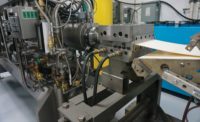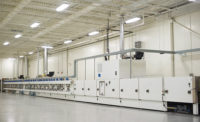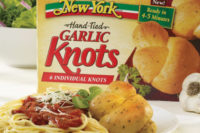Despite all the reports that Americans are trying to eat healthier, baked goods and snack sales statistics indicate that many still indulge in an occasional treat, like a doughnut or potato chips. Doughnut sales, for instance, reached $1.25 billion in April 2015, up 3.61 percent from the previous year, according to IRI, Chicago, while potato chips sales climbed to $7.23 billion in May 2015, up 4.27 percent from 2014. That’s good news for manufacturers of fried dough and snack products.
Equally good news for bakers and snack manufacturers is the availability of fryers that enable them to increase production volume, while reducing related costs. And because these fryers can handle different types of oils and fats, processors can use oils and fats with healthier profiles to create the kind of better-for-you products, which consumers are also requesting.
“We’re seeing pretty strong demand for fryers,” says David Moline, sales and marketing manager, Moline Machinery LLC, Duluth, MN. “It seems like a good time to be investing in capital equipment.”
The company’s Libra fryers, which include its industrial doughnut fryers, are being used by many high-volume manufacturers. Still, the company is constantly being asked what the highest volume frying system that it can make is. “That’s what we’re being asked more now than ever,” says Moline. “The constant theme for manufacturers out there seems to be, ‘I need to get the lowest cost per unit that I can possibly get out of a production system.’”
To help manufacturers reduce production costs related to energy usage, Moline Machinery offers the Libra Dual Fuel Fryer, which runs on gas or electricity. “The Dual Fuel Fryer makes an excellent replacement fryer for medium-volume systems in the 16–26-foot range,” says Moline. “The electrical requirements aren’t going to be too much, so it could be a drop-in replacement for a fryer that someone already has. Users will really see a boost in performance with the addition of the continuous sediment removal and the oil filtration system.” These two features also help maintain frying oil quality and reduce the need for cleaning.
While Moline’s Libra fryers are predominantly used to make doughnuts, when fitted with submergers, they can be used to make hand-held pies, churros, funnel cakes and other products that need to be submerged in hot oil.
And when it comes to the oil, Moline’s fryers, especially its electric models, offer users another advantage: They minimize oil breakdown. “What’s hardest on the oil is exposing it to very high temperatures,” Moline explains. “The lower the temperature of our electric elements and gas burners, the lower the heating temperature and the better off [manufacturers] are as far as oil degradation goes. We’ve had good luck with trans-fat-free oils, palm oils, you name it. To date, we haven’t encountered an oil that won’t work.”
Modern production facilities need fast, powerful, reliable, compact equipment, notes Ron Reed, R&D chef, Firex USA, Chicago. “The Firex Multifry is safe, reliable equipment that guarantees a continuous working cycle, free of technical problems,” he says.
The high-performance, industrial fryer can be used to make fritters, doughnuts, pastries and various chips. Features include a 1-inch discharge drain valve with a heat-resistant handle; an electromechanical safety thermostat with visual and acoustic signals; a temperature probe in direct contact with oil for precise temperature control (± 1°C); an automatic basket drop/lift; and a basket submersion timer.
The fryer also has a melting function specifically for lard and other alimentary fats. “When ‘fat’ is selected, the heating temperature is at a 40 percent reduced setting to prevent the fat from burning before the total volume is melted,” explains Reed, adding that the Multifry gradually melts 132 pounds of lard in 35 minutes to 230°F. Once melted, the lard heats to the programmed cooking temperature.
The Multifry is designed for easy use and maintenance, says Reed. The front lower panel opens for easy access to the discharge valve and oil drain pan. Heating elements tilt up for easy access and cleaning (electric models only). Automatic basket lowering keeps the operator out of the splash zone, and the basket rolls on a track system with an ergonomic lever for bottom dumping, eliminating the hot oil drips or messes on the production floor during peak production periods. An optional oil filter trolley keeps the Multifry free of food particles and operating efficiently.
Bakers considering expanding their line of fried products are also seeking out equipment that works in conjunction with fryers, such as depositors. For instance, Hinds-Bock Corp., Bothell, WA, offers a depositor that can be used to make funnel cakes. The 7P-05 is a custom, multi-piston, servo-motor-driven machine with a servo-driven, moving spout bridge that moves multiple tip positive shut-off spouts in three axes to achieve the unique funnel cake shape. It automatically, cleanly and efficiently makes 210 funnel cakes per minute, says Lance Aasness, the company’s executive vice president. The company also manufactures custom subsurface fryer depositors for manufacturing products such as potato pancakes.
The 7P-05 offers operators ease of use, flexibility and easy sanitation, as well as helps the company’s customers save labor, run faster, make higher-quality products and reduce product giveaway, Aasness adds.
Oil considerations
Fryers that maintain oils at the proper temperature during production and incorporate features that help keep oil clean and sediment-free are essential to producing tasty fried dough products and snacks. Using the right oil is important, too.
“From canola, sunflower and olive oil to coconut and corn oil, manufacturers are inundated with choices,” says Arnaud Jansse, food technologist, Florigo Industry B.V. (a tna company), Woerden, Netherlands, which introduced a high-performance 25-ton/hour fryer for French fries and other specialty potato products last fall. “However, there are several considerations for bakery and snack manufacturers switching to healthier oils. Some types of oil, for example, create less harmful compounds, but are less stable at the heating stage, such as sunflower oil. This means they produce high levels of free radicals when they are heated, thus reducing the nutritional properties of the end product. When an oil is less stable, shelf stability also becomes a significant concern.
“Oils that are rich in essential fatty acids and other polyunsaturated fats are the most fragile of oils,” he continues. “Because their shelf life is generally shorter compared to oils that contain saturated and monounsaturated fats, snacks processed in healthier oils can become less stable during their shelf life. In addition, these are generally more costly due to their nutritional value and provenance.” Putting in place good oil-management practices, including frequent oil filtration, temperature control and regular cleaning is, therefore, imperative to reducing oil degradation, Jansse adds.
Dow AgroSciences’ Omega-9 Canola and Sunflower Oils are naturally stable and replace the need for partial hydrogenation or preservatives for oil stability, says Mary K. LaGuardia, Omega-9 Oils market manager at the Indianapolis-based company. Available in frying oils, spray oils and shortenings, they can be used to fry snacks, such as potato chips or similar salty products; roast nuts; and fry doughnuts. (Omega-9 Sunflower Oil, which is still in development, is expected to launch soon.)
“Due to its uniquely high monounsaturated fat content and natural stability, Omega-9 Canola Oil is a cost-effective oil solution for longer and cleaner frying, extended product shelf life and superior versatility for today’s demanding food manufacturing environments,” says LaGuardia, adding that Omega-9 Canola Oil also has among the lowest saturated fat of commercial cooking oils and zero trans fat.
While consumers will be glad to hear about an oil with less saturated fat and no trans fat—both often associated with heart disease—manufacturers may be interested to learn that Omega-9 Canola Oil results in less buildup of “muck” from polymerization in fryers, ventilation systems and general working areas, according to LaGuardia.
Still, bakers and snack manufacturers realize that’s impossible to totally prevent oil contaminants during the frying process, regardless of the type of oil used. Therefore, adsorbents like Dalsorb oil purifier from The Dallas Group of America Inc., Louisville, KY, offer another oil management tool.
Dalsorb is an active filter aid designed to remove degradation contaminants from all types of frying oils used to produce a broad spectrum of fried products. According to Chris Abrams, director, product management, Dalsorb eliminates the need to discard frying oil and allows operators to meet customer and consumer quality requirements.
Dalsorb oil purifier offers fried food producers two economic benefits: the elimination of frying oil discard and frying line uptime. “Our purification process can be designed such that a fry line’s product throughput, uptime and oil-quality changeovers are not predicated on frying oil quality or flavor carryover concerns,” explains Abrams. “This improves product shelf life and taste. Additionally, it eliminates the need to discard frying oil for high contaminant levels, off-flavor, and/or dark color. Dalsorb oil management solutions provide the end user with simplified frying operations, improved profits, consistent product quality and lower customer complaints.”
Demand for healthier snack products is reshaping the food-processing industry, says Jansse, when asked what’s next for the industrial fryer category. “From experimenting with new ingredients to developing groundbreaking processing technologies, innovation is extensive,” he notes. “As such, there is a real need and place for creativity in our industry. And while emphasis has been previously placed on optimizing the frying process to improve the healthfulness of snack products, efforts are now focusing on the advancement of pre-processing technologies, including blanching and pulsed electric field (PEF) technology. Each of these techniques has proven benefits in maintaining the structural quality, as well as the nutritional value, of snack products. At the same time, the implementation of PEF technology can also lead to significant efficiency savings, such as reduced frying times.”
More efficient fryers, improved frying technology and healthier frying oils will enable bakers and snack manufacturers to produce more and better-for-you products, while reducing their production costs. Consumers, in turn, will be able to indulge in healthier, affordable treats. It’s a win-win for both groups—like a doughnut with icing and sprinkles.













